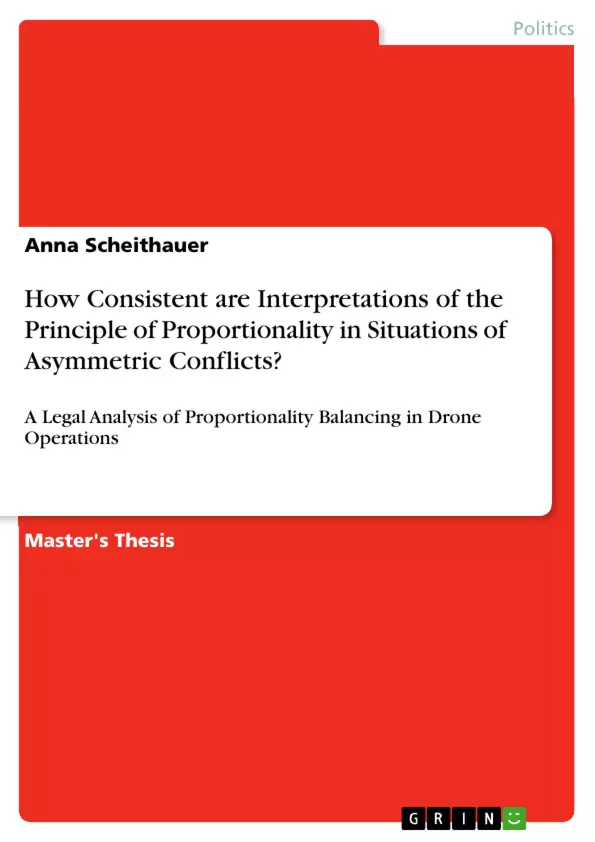In this paper I present a holistic approach to identify how consistent interpretations of jus in bello proportionality regarding precision strikes in the context of counterinsurgency operations are by examining both consistency in substance and process. I hypothesize that there is high inconsistency in proportionality balancing, and will illustrate that it is both a theoretical and practical problem by using a mixed-methods design of empirical and theoretical analysis. Doing so, I will move beyond a positivist reading of the law to present my argument though a normative framework. I will argue that to fully comprehend this inconsistency one needs to understand the normative relationship between IHL and IHRL.
Structurally, I begin the thesis with an empirical analysis of case law and of the counterinsurgency policy of the US to demonstrate (in)consistency by rethinking it in four specific categories: scope, content, time, certainty. The purpose of this section is to evidence variance in interpretations of the proportionality variables and of the balancing act in ex-post (jurisprudence) and ex-ante (policy) assessments. Secondly, I will engage in a purposive analysis of the legal framework presenting theoretical approaches on the relationship of IHL with IHRL. This is to dismiss inconsistency in proportionality balancing as a ROL problem by showing that there is a higher (normative) purpose behind it. In the final chapter, I will apply the theoretical findings to the empirical discoveries to demonstrate that inconsistency is due to a “proportionality continuum”. This section will illustrate that inconsistency is not inherently bad as long as it serves the protective purpose intrinsic to both IHL and IHRL, which suggests changing policy rather than the law.
Inhaltsverzeichnis (Table of Contents)
- Abstract
- List of Abbreviations
- Introduction
- Empirical Analysis: Consistency in Substance
- Scope
- Content
- Time
- Certainty
- Empirical Analysis: Consistency in Process
- Purposive Analysis: Proportionality Balancing as a ROL Problem
- The Normative Relationship of IHL and IHRL
- Purposive Analysis of IHL
- Purposive Analysis of IHRL
- The Proportionality Continuum: Applying the Theoretical Findings to the Empirical Discoveries
- Conclusion
Zielsetzung und Themenschwerpunkte (Objectives and Key Themes)
This paper examines the consistency of interpretations of jus in bello proportionality in the context of counterinsurgency operations, specifically focusing on precision strikes. It argues that inconsistency exists both in substance and process, and seeks to understand the normative relationship between International Humanitarian Law (IHL) and International Human Rights Law (IHRL) in relation to this inconsistency.
- Inconsistency in proportionality balancing in counterinsurgency operations.
- The normative relationship between IHL and IHRL.
- The concept of a "proportionality continuum" and its implications for policy and law.
- The role of precision strikes in modern warfare and their impact on civilian casualties.
- The balancing act between military advantage and civilian protection.
Zusammenfassung der Kapitel (Chapter Summaries)
The paper begins with an empirical analysis of case law and US counterinsurgency policy, examining consistency in four categories: scope, content, time, and certainty. It then moves to a purposive analysis of the legal framework, exploring the relationship between IHL and IHRL in order to address the inconsistency in proportionality balancing as a Rule of Law (ROL) problem. The final chapter applies the theoretical findings to the empirical discoveries, demonstrating that inconsistency is due to a "proportionality continuum" and arguing for policy changes rather than legal modifications.
Schlüsselwörter (Keywords)
This paper delves into the complexities of proportionality balancing in asymmetric conflicts, particularly in the context of drone operations. It examines key concepts such as arbitrary deprivation of life, collateral damage, distinction, precision strikes, targeted killings, and the interplay between international humanitarian law and international human rights law. The research explores the implications of inconsistency in proportionality balancing, highlighting the need for a comprehensive understanding of the "proportionality continuum" and its impact on civilian protection.
- Arbeit zitieren
- Anna Scheithauer (Autor:in), 2015, How Consistent are Interpretations of the Principle of Proportionality in Situations of Asymmetric Conflicts?, München, GRIN Verlag, https://www.grin.com/document/350561



